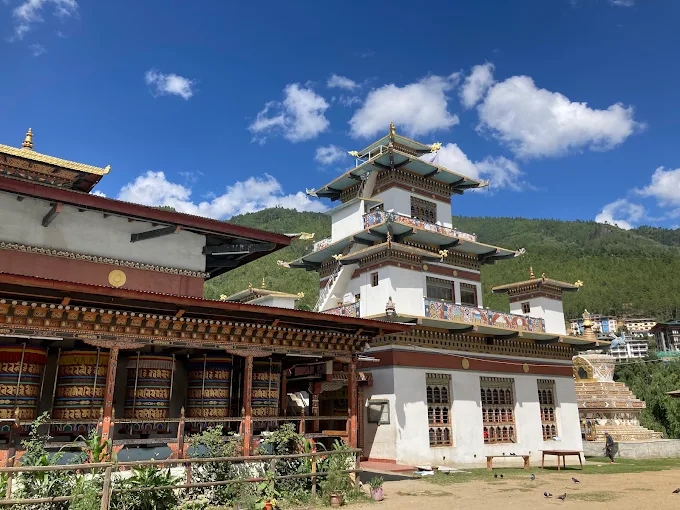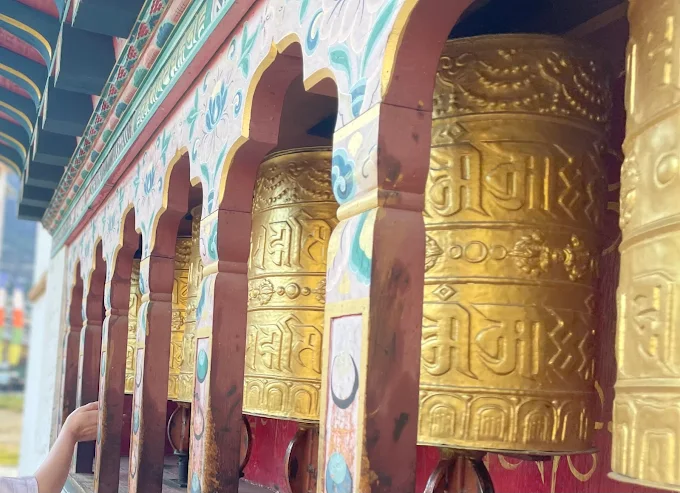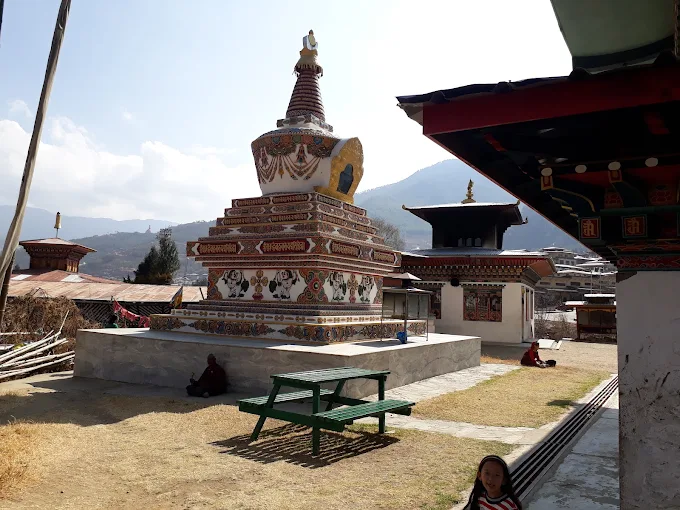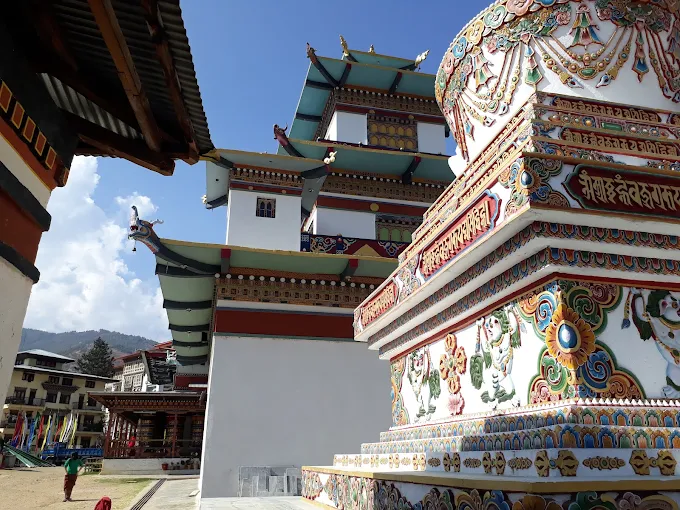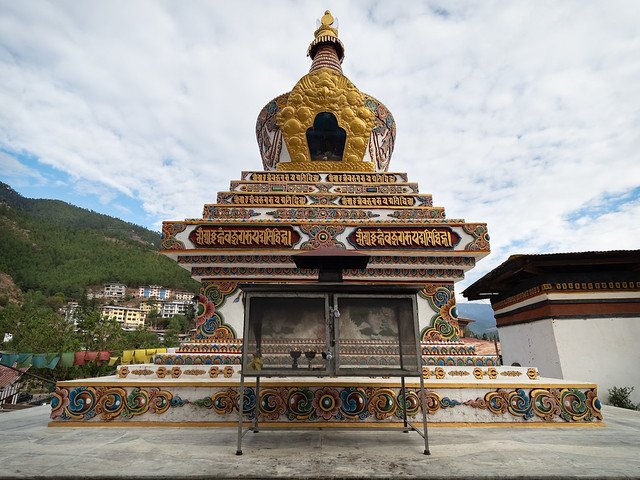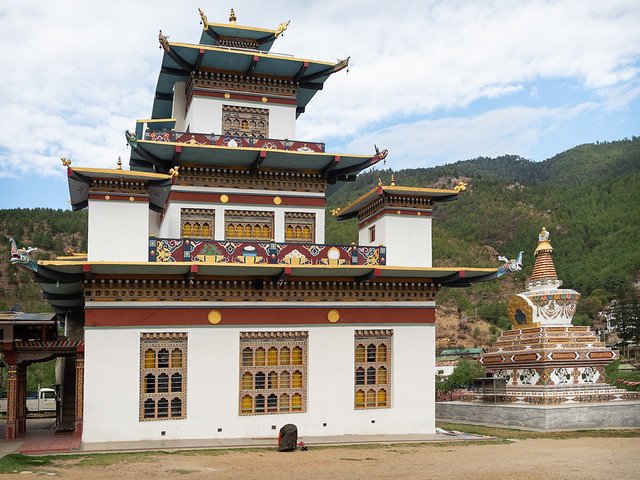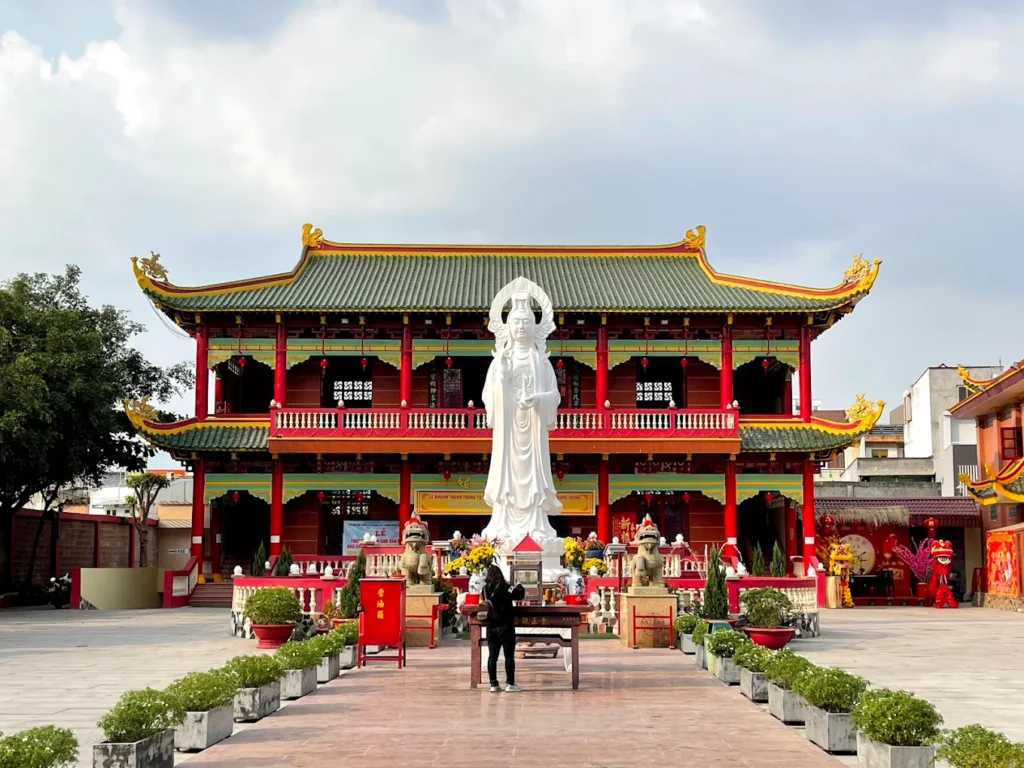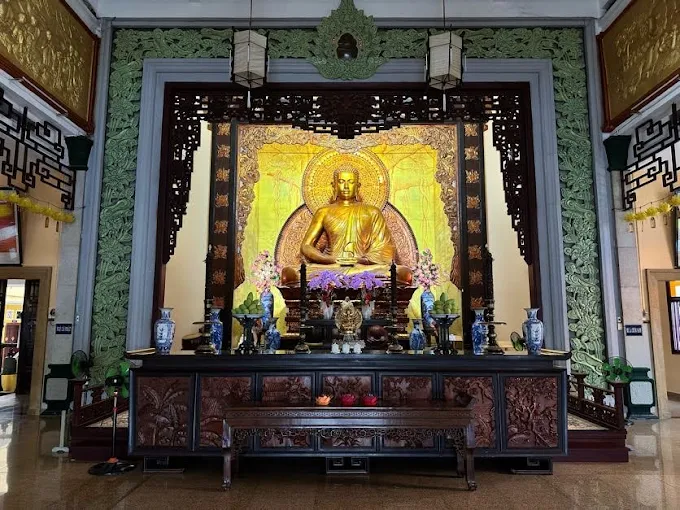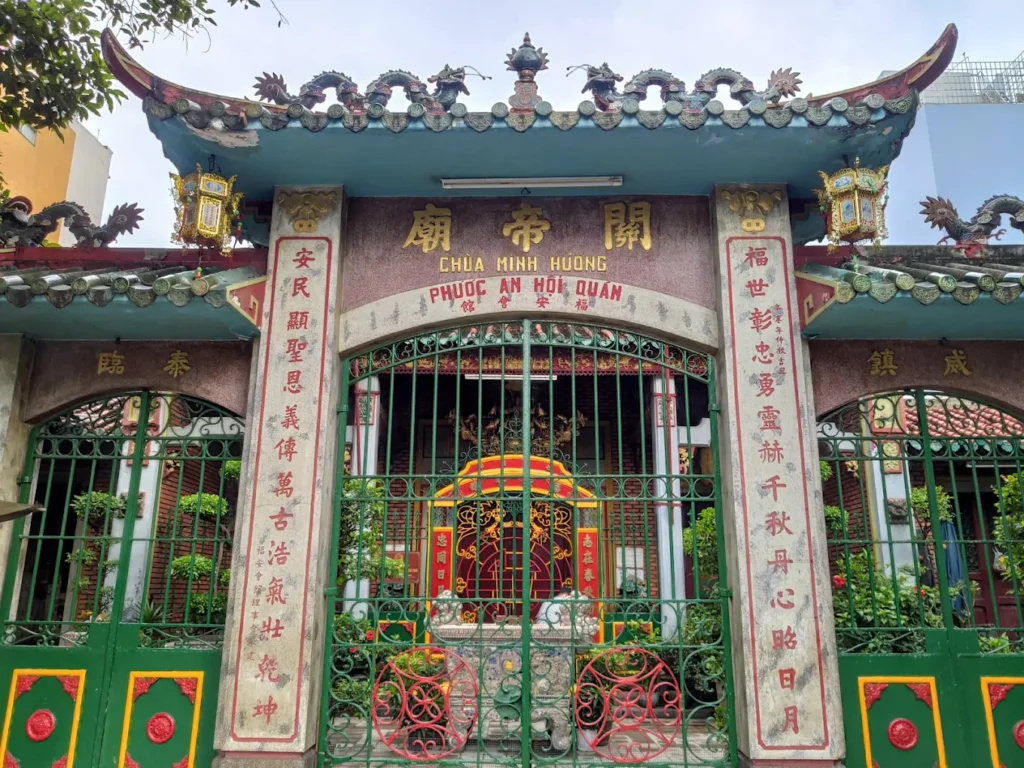Changlingmethang Zangdok Pelri Temple: Thimphu’s Celestial Tribute to Guru Rinpoche
As dawn breaks over Thimphu Valley, the Changlingmethang Zangdok Pelri Temple glows softly near the vibrant Weekend Market, its golden spire catching the first light. Built in 1990 by Dasho Aku Tongmi, the composer of Bhutan’s national anthem, this modern lhakhang [temple] embodies the celestial paradise of Guru Rinpoche, the 8th-century tantric master who brought Buddhism to Bhutan. Inside, a towering four-meter statue of Guru Rinpoche, flanked by his eight manifestations, commands reverence, while colorful murals narrate the Buddha’s life. The temple, rooted in the Nyingma tradition, hums with the rhythmic spin of prayer wheels and the scent of juniper incense, offering a tranquil oasis amidst Thimphu’s urban pulse. Its three-story structure, adorned with intricate Bhutanese artistry, draws locals, tourists, and pilgrims to circumambulate its sacred perimeter, connecting them to the spiritual legacy of Padmasambhava.
Abode of the Lotus-Born: Overview and Significance
Changlingmethang Zangdok Pelri Temple, located in Thimphu’s Changlingmethang area, is a modern yet profound testament to Bhutan’s Vajrayana Buddhist heritage. Constructed to replicate Guru Rinpoche’s Copper-Colored Mountain Paradise, it serves as a spiritual hub for devotion, cultural preservation, and community engagement, reflecting Bhutan’s commitment to Gross National Happiness.
Historical Roots and Legacy
The temple’s origins trace to 1990, when Dasho Aku Tongmi, a revered Bhutanese musician and cultural figure, envisioned a lhakhang to honor Guru Rinpoche, also known as Padmasambhava. Unlike ancient Bhutanese monasteries, its modern construction aligns with urban Thimphu’s growth, yet it upholds Nyingma traditions. The temple’s design draws inspiration from Zangdok Pelri, the mythical paradise described in Nyingma texts as a mandala-like realm with a three-roofed pagoda, symbolizing Guru Rinpoche’s enlightened vision. Its establishment marked a cultural milestone, reinforcing Bhutan’s spiritual identity amidst modernization.
- Key Milestones:
- 1990: Temple constructed under Dasho Aku Tongmi’s patronage.
- Ongoing: Serves as a pilgrimage site and cultural landmark in Thimphu.
- Notable: Houses an elephant skull unearthed during construction, displayed near the Mani Dungkhar Lhakhang.
Cultural and Spiritual Significance
As a representation of Guru Rinpoche’s paradise, the temple holds immense spiritual weight in the Nyingma School, which emphasizes tantric practices like Dzogchen [Great Perfection], a meditative path to realize the mind’s innate purity. It attracts devotees seeking blessings and tourists exploring Bhutanese Buddhism. The temple’s urban setting makes it accessible, fostering cultural continuity in a rapidly developing capital. Its role in hosting rituals strengthens community ties and Bhutan’s global image as a Buddhist sanctuary.
- Cultural Roles:
- Preserves Nyingma teachings through rituals and iconography.
- Enhances Thimphu’s spiritual tourism, alongside sites like Tashichho Dzong.
- Symbolizes Bhutan’s blend of tradition and modernity.
Community and Global Connections
The temple engages Thimphu’s residents through daily prayers and festival celebrations, drawing locals for circumambulation and offerings. Its proximity to the Weekend Market makes it a cultural anchor, where tourists interact with Bhutanese devotees. Internationally, it attracts pilgrims from India, Nepal, and Western countries, who connect with its serene ambiance and Guru Rinpoche’s universal appeal. The temple’s accessibility fosters cross-cultural exchanges, supported by Bhutan’s tourism initiatives.
- Community Impact:
- Hosts communal prayers, fostering spiritual unity.
- Draws global visitors, promoting Bhutanese Buddhist heritage.
- Supports local artisans through ongoing maintenance of murals and statues.
The temple’s vibrant energy, echoing Guru Rinpoche’s legacy, flows seamlessly into its architectural splendor, where sacred art and design converge to inspire awe.
Paradise in Stone: Architectural and Spiritual Features
Changlingmethang Zangdok Pelri Temple’s three-story structure, built in 1990, showcases Bhutanese craftsmanship with vibrant exteriors and sacred interiors. Its design, rooted in the Zangdok Pelri mandala, harmonizes with Thimphu’s urban landscape, offering a spiritual retreat amidst the city’s bustle.
Iconic Design and Structures
The temple’s architecture follows traditional Bhutanese principles, with whitewashed walls, a golden spire, and wooden beams painted with auspicious motifs. Its three-story layout reflects the Zangdok Pelri paradigm: the ground floor represents the Nirmanakaya [emanation body], the second floor the Sambhogakaya [enjoyment body], and the top floor the Dharmakaya [truth body]. A small park with prayer wheels and a fountain enhances its serene ambiance, inviting circumambulation. The adjacent Mani Dungkhar Lhakhang, with its large prayer wheels, complements the main structure.
- Design Highlights:
- Three-story lhakhang with golden spire and colorful frescoes.
- Enclosed park with prayer wheels and a ball fountain.
- Urban integration, blending tradition with Thimphu’s modernity.
Sacred Statues and Relics
The temple’s heart is its statuary, centered on a four-meter statue of Guru Rinpoche on the ground floor, gilded and adorned with silks, surrounded by his eight manifestations (e.g., Padma Jungnas, Senge Dradrok). These bronze figures, crafted by Bhutanese artisans, depict Guru Rinpoche’s transformative roles. The second floor houses statues of Avalokiteshvara [Chenrezig], the bodhisattva of compassion, Shabdrung Ngawang Namgyal, and eight Bodhisattvas, symbolizing enlightened qualities. The top floor enshrines Buddha Amitabha, representing infinite light and liberation. Murals of the Buddha’s life adorn the walls, enhancing the sacred narrative.
- Statue Details:
- Guru Rinpoche: 4-meter gilded bronze, central figure with serene expression.
- Avalokiteshvara: Four-armed, symbolizing compassion, ~2 meters tall.
- Amitabha: Top-floor statue, radiating calm, crafted in bronze.
Artistry and Environmental Harmony
Bhutanese artisans from the Zorig Chusum [13 traditional crafts] tradition crafted the temple’s vibrant murals and carvings, using natural pigments and sustainable timber. The exterior walls, painted in crystal, lapis lazuli, ruby, and sapphire hues, reflect Zangdok Pelri’s cosmic palette. The temple’s modest footprint minimizes environmental impact, aligning with Bhutan’s eco-conscious ethos. Its park, with blooming flowers and a pond, fosters tranquility and connection to nature.
- Artistic Features:
- Murals depicting Buddha’s life, painted with mineral pigments.
- Carved wooden beams with lotus and cloud motifs.
- Eco-friendly design, using local materials and minimal land disruption.
The temple’s sacred artistry and serene setting prepare visitors for its living traditions, where rituals bring Guru Rinpoche’s teachings to life.
Rituals of the Copper-Colored Mountain: Rituals and Practices
Changlingmethang Zangdok Pelri Temple pulses with daily and seasonal rituals, rooted in the Nyingma School’s tantric practices. These ceremonies, centered on Guru Rinpoche, foster devotion and community engagement, offering visitors a window into Bhutanese spirituality.
Daily and Unique Rituals
Each morning, monks and devotees chant mantras, such as Guru Rinpoche’s “Om Ah Hung Vajra Guru Padma Siddhi Hung,” filling the temple with resonant tones. Butter lamps are lit before the Guru Rinpoche statue, their glow symbolizing wisdom. Unique to the temple, devotees spin prayer wheels while circumambulating, accumulating merit. These practices, grounded in Dzogchen, emphasize meditative awareness and compassion.
- Daily Practices:
- Morning mantra recitations, ~1–2 hours.
- Butter lamp offerings for wisdom and blessings.
- Circumambulation with prayer wheel spinning, open to visitors.
Festival Traditions
The temple hosts vibrant festivals, notably Losar [Bhutanese New Year] in February/March and Guru Rinpoche Day on the 10th lunar day monthly. During Losar, monks perform cham [sacred dances] and offer torma [ritual cakes], honoring Guru Rinpoche’s manifestations. These events, distinct from daily rituals, draw crowds for communal prayers and celebrations, with the temple adorned in colorful banners.
- Festival Highlights:
- Losar: 3–5 days of cham dances and torma offerings.
- Guru Rinpoche Day: Monthly prayers and lamp offerings.
- Public participation, enhancing festive vibrancy.
Community and Visitor Engagement
The temple fosters community through daily prayers and educational outreach, where monks explain Nyingma teachings to visitors. Tourists are invited to join circumambulation or light butter lamps, fostering cultural exchange. Local devotees, especially during festivals, strengthen communal bonds, while the temple’s urban location ensures accessibility for all.
- Engagement Activities:
- Guided prayer sessions for visitors, ~20–30 minutes.
- Talks on Guru Rinpoche’s legacy, offered by resident monks.
- Community prayers during festivals, open to all.
The temple’s rituals, vibrant with devotion, pave the way for practical guidance, ensuring visitors can fully engage with its spiritual offerings.
Navigating the Celestial Abode: Visitor Information
Changlingmethang Zangdok Pelri Temple, nestled near Thimphu’s Weekend Market, is easily accessible for travelers seeking spiritual and cultural immersion. Its urban setting, combined with clear etiquette and nearby attractions, makes it a must-visit in Thimphu.
Navigating the Temple
Located in Changlingmethang, the temple is a 5–10-minute walk from Thimphu’s main town or a short taxi ride (~Nu 100). Follow Changlingmethang Road past the Weekend Market, with the temple’s golden spire visible near the Wang Chhu riverbank. The entrance, marked by prayer wheels and a fountain, leads to the main lhakhang. Parking is available nearby for private vehicles.
- Navigation Tips:
- Walk from Thimphu town via Changlingmethang Road.
- Look for the temple’s spire near the Weekend Market.
- Expect a 2-minute walk from parking to entrance.
Practical Details and Etiquette
The temple is open daily from 8 AM to 6 PM, with no entry fee, though donations support maintenance. Visitors must dress conservatively (long sleeves, no shorts), remove shoes before entering, and refrain from photography inside the lhakhang. Silence phones and avoid pointing at statues. The full address is Changlingmethang, Thimphu 11001, Bhutan. Accessibility is limited for wheelchairs due to steps at the entrance.
- Logistics:
- Address: Changlingmethang, Thimphu 11001, Bhutan.
- Hours: 8 AM–6 PM, daily.
- Transport: Taxi (~Nu 100) or walk from town.
- Etiquette: Dress modestly, no indoor photography, donate if possible.
Immersive Experiences and Surroundings
Visitors can light butter lamps (~Nu 20) or join circumambulation, spinning prayer wheels for merit. Engaging with monks during non-ritual hours offers insights into Nyingma practices. Nearby, the Weekend Market (2-minute walk) offers local crafts and produce, while the National Memorial Chorten (10-minute drive) provides further cultural exploration. The Centenary Farmers Market (5-minute walk) showcases Bhutanese cuisine.
- Immersive Tips:
- Light a butter lamp for blessings.
- Join circumambulation during morning prayers.
- Visit the Weekend Market and National Memorial Chorten nearby.
The temple’s accessibility and cultural richness invite deeper exploration of its philosophical and symbolic significance, connecting visitors to Bhutan’s spiritual heart.
Wisdom of Zangdok Pelri: Cultural and Spiritual Insights
Changlingmethang Zangdok Pelri Temple offers profound insights into Nyingma Buddhism, blending philosophical depth with cultural symbolism. Its urban role underscores its relevance as a spiritual and cultural beacon.
Philosophical Foundations
The temple’s Nyingma practices center on Dzogchen, a meditative path teaching that the mind’s true nature is pure and luminous, akin to a clear sky. Guru Rinpoche’s teachings, embodied in the temple’s rituals, emphasize compassion and liberation through awareness. Visitors can explore these concepts through monk-led talks, aligning with Bhutan’s focus on mindfulness and happiness.
- Key Concepts:
- Dzogchen: Cultivating non-dual awareness for enlightenment.
- Compassion: Reflected in Guru Rinpoche and Avalokiteshvara’s iconography.
Cultural and Symbolic Depth
The temple’s art carries deep symbolism. The eight manifestations of Guru Rinpoche represent his transformative roles, from teacher to exorcist, guiding devotees toward liberation. Murals of the Buddha’s life narrate the path to enlightenment, serving as meditative aids. The temple’s three-story design mirrors Zangdok Pelri’s cosmic hierarchy, connecting the physical to the divine.
- Symbolic Elements:
- Guru Rinpoche’s manifestations: Eight forms symbolizing versatility.
- Three-story structure: Reflects Nirmanakaya, Sambhogakaya, Dharmakaya.
Community and Environmental Resilience
The temple fosters community through prayers and festivals, uniting locals and tourists. Its eco-conscious design, using sustainable materials, aligns with Bhutan’s environmental policies. Outreach programs, such as talks for youth, ensure cultural continuity, reinforcing the temple’s role in Thimphu’s social fabric.
- Resilience Efforts:
- Community prayers, promoting social cohesion.
- Sustainable architecture, minimizing environmental impact.
The temple’s teachings and symbols resonate with universal themes of wisdom and harmony, inviting visitors to experience its transformative essence.
Why You Have to Get to Changlingmethang Zangdok Pelri Temple
Changlingmethang Zangdok Pelri Temple is a must-visit for its serene beauty and profound connection to Guru Rinpoche’s legacy. Nestled in Thimphu’s heart, its three-story lhakhang, with a towering Guru Rinpoche statue and vibrant murals, captures Bhutan’s Nyingma heritage. The temple’s daily rituals, from mantra chants to prayer wheel spinning, offer an immersive spiritual experience, while its urban setting near the Weekend Market ensures accessibility. Its role in fostering community and cultural preservation, supported by Dasho Aku Tongmi’s vision, makes it a living testament to Bhutan’s Buddhist soul. As prayer wheels hum and incense wafts, the temple beckons travelers, seekers, and researchers to discover Thimphu’s celestial oasis, where devotion and artistry intertwine.
